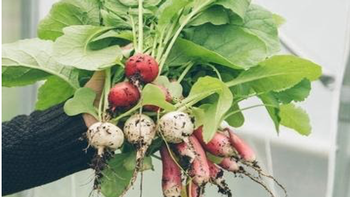Radish
-
Scientific NameRaphanus sativus
-
General InformationA crisp, peppery, root vegetable in the Brassica family. Both roots and tops may be eaten. Radishes are easy to grow. They are available in many shapes, sizes and colors. Smaller summer radishes mature quickly while larger winter radishes take several months to mature.
 Radishes grow easily and quickly. Some small-rooted varieties area ready in a month or less from the day of seeding. It's a great vegetable for the be
Radishes grow easily and quickly. Some small-rooted varieties area ready in a month or less from the day of seeding. It's a great vegetable for the be -
When to Plant
Depending upon microclimate, radish seeds may be planted most anytime. Radishes do not thrive in wet periods or in prolonged heat. Summer radishes are small and brightly colored in shades of red, pink, white or purple. Winter radishes are larger, and typically white, green or black. Most larger radishes are best planted in late summer to mature in fall and winter, but some large radishes may be sown in the spring. Check seed package.
-
Planting
Direct seed thinly and half inch deep. Plant four to eight inches apart in row spacing of eight to 12 inches. Larger winter varieties need more space than spring varieties so thin to the farther spacing. Use thinnings in salads or omelets.
In sunny, hot microclimates, plant radishes where they will receive some shade. In foggy areas, plant where they will receive full sun all day. For continuous supply, plant seeds in succession every two weeks during the growing season.
-
Soil Requirements
Radishes will grow in most soils, but grow best in light, well-drained, sandy loam. The plants make poor roots if soil has excessive nitrogen.
-
Water Requirements
Water regularly.
-
Fertilizing
If the soil is well-balanced at planting, no additional fertilizer is necessary as the crop matures quickly.
-
Pollination
While pollination is necessary to produce seeds for root vegetables, garden pollinators are not necessary because radishes are eaten before pollination occurs.
-
Harvesting
Frequent picking prolongs the harvest. Larger radishes may be harvested over a longer time as they keep better in the soil. Smaller radishes will deteriorate if left in the soil too long.
-
Storage
Wash, dry, then separate the leaves from the root before storing separately in air tight containers in the refrigerator. Small radishes will keep up to one week. Larger varieties will keep up to two weeks.
-
Good Varieties for Marin
Think beyond the typical round red varieties. Most varieties will succeed in our climate, including: ‘French Breakfast’ ‘Easter Egg’ ‘Purple Plum’ ‘Watermelon’.
One of the better known large radishes is the Daikon radish.
-
Helpful Tips
Rotate crop to reduce possibility of disease.
Plant winter varieties so that they mature around the first fall frost date.If plant forms a flower stem, known as bolting, pull and compost as root will no longer develop or be succulent.
-
Common Problems
Roots fail to form if not thinned. Radishes become tough and woody or can crack if left too long in the ground.
-
Pests- Diseases & More
Cabbage maggots are the chief pest. Fall and winter grown crops less affected as flies are inactive. Learn more about cabbage maggots.

